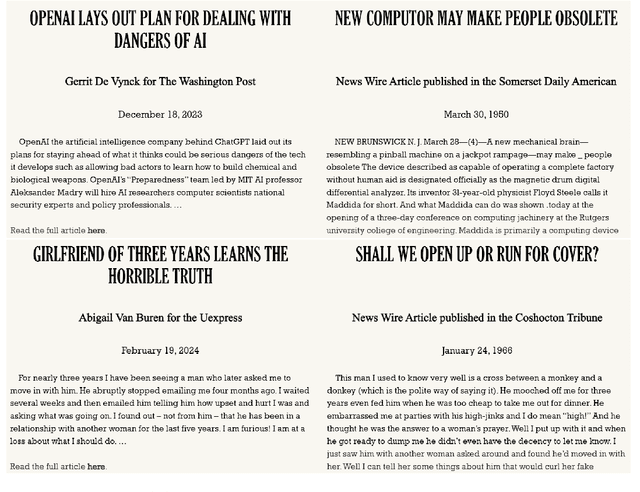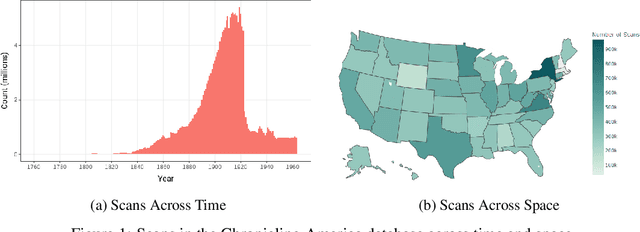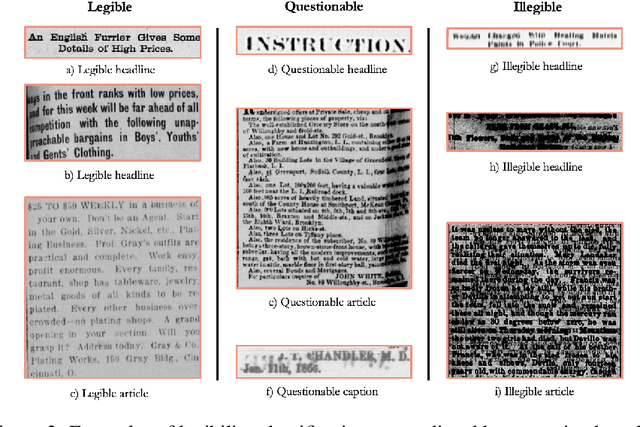Tom Bryan
News Deja Vu: Connecting Past and Present with Semantic Search
Jun 21, 2024



Abstract:Social scientists and the general public often analyze contemporary events by drawing parallels with the past, a process complicated by the vast, noisy, and unstructured nature of historical texts. For example, hundreds of millions of page scans from historical newspapers have been noisily transcribed. Traditional sparse methods for searching for relevant material in these vast corpora, e.g., with keywords, can be brittle given complex vocabularies and OCR noise. This study introduces News Deja Vu, a novel semantic search tool that leverages transformer large language models and a bi-encoder approach to identify historical news articles that are most similar to modern news queries. News Deja Vu first recognizes and masks entities, in order to focus on broader parallels rather than the specific named entities being discussed. Then, a contrastively trained, lightweight bi-encoder retrieves historical articles that are most similar semantically to a modern query, illustrating how phenomena that might seem unique to the present have varied historical precedents. Aimed at social scientists, the user-friendly News Deja Vu package is designed to be accessible for those who lack extensive familiarity with deep learning. It works with large text datasets, and we show how it can be deployed to a massive scale corpus of historical, open-source news articles. While human expertise remains important for drawing deeper insights, News Deja Vu provides a powerful tool for exploring parallels in how people have perceived past and present.
EfficientOCR: An Extensible, Open-Source Package for Efficiently Digitizing World Knowledge
Oct 16, 2023Abstract:Billions of public domain documents remain trapped in hard copy or lack an accurate digitization. Modern natural language processing methods cannot be used to index, retrieve, and summarize their texts; conduct computational textual analyses; or extract information for statistical analyses, and these texts cannot be incorporated into language model training. Given the diversity and sheer quantity of public domain texts, liberating them at scale requires optical character recognition (OCR) that is accurate, extremely cheap to deploy, and sample-efficient to customize to novel collections, languages, and character sets. Existing OCR engines, largely designed for small-scale commercial applications in high resource languages, often fall short of these requirements. EffOCR (EfficientOCR), a novel open-source OCR package, meets both the computational and sample efficiency requirements for liberating texts at scale by abandoning the sequence-to-sequence architecture typically used for OCR, which takes representations from a learned vision model as inputs to a learned language model. Instead, EffOCR models OCR as a character or word-level image retrieval problem. EffOCR is cheap and sample efficient to train, as the model only needs to learn characters' visual appearance and not how they are used in sequence to form language. Models in the EffOCR model zoo can be deployed off-the-shelf with only a few lines of code. Importantly, EffOCR also allows for easy, sample efficient customization with a simple model training interface and minimal labeling requirements due to its sample efficiency. We illustrate the utility of EffOCR by cheaply and accurately digitizing 20 million historical U.S. newspaper scans, evaluating zero-shot performance on randomly selected documents from the U.S. National Archives, and accurately digitizing Japanese documents for which all other OCR solutions failed.
American Stories: A Large-Scale Structured Text Dataset of Historical U.S. Newspapers
Aug 24, 2023



Abstract:Existing full text datasets of U.S. public domain newspapers do not recognize the often complex layouts of newspaper scans, and as a result the digitized content scrambles texts from articles, headlines, captions, advertisements, and other layout regions. OCR quality can also be low. This study develops a novel, deep learning pipeline for extracting full article texts from newspaper images and applies it to the nearly 20 million scans in Library of Congress's public domain Chronicling America collection. The pipeline includes layout detection, legibility classification, custom OCR, and association of article texts spanning multiple bounding boxes. To achieve high scalability, it is built with efficient architectures designed for mobile phones. The resulting American Stories dataset provides high quality data that could be used for pre-training a large language model to achieve better understanding of historical English and historical world knowledge. The dataset could also be added to the external database of a retrieval-augmented language model to make historical information - ranging from interpretations of political events to minutiae about the lives of people's ancestors - more widely accessible. Furthermore, structured article texts facilitate using transformer-based methods for popular social science applications like topic classification, detection of reproduced content, and news story clustering. Finally, American Stories provides a massive silver quality dataset for innovating multimodal layout analysis models and other multimodal applications.
Efficient OCR for Building a Diverse Digital History
Apr 05, 2023Abstract:Thousands of users consult digital archives daily, but the information they can access is unrepresentative of the diversity of documentary history. The sequence-to-sequence architecture typically used for optical character recognition (OCR) - which jointly learns a vision and language model - is poorly extensible to low-resource document collections, as learning a language-vision model requires extensive labeled sequences and compute. This study models OCR as a character level image retrieval problem, using a contrastively trained vision encoder. Because the model only learns characters' visual features, it is more sample efficient and extensible than existing architectures, enabling accurate OCR in settings where existing solutions fail. Crucially, the model opens new avenues for community engagement in making digital history more representative of documentary history.
 Add to Chrome
Add to Chrome Add to Firefox
Add to Firefox Add to Edge
Add to Edge